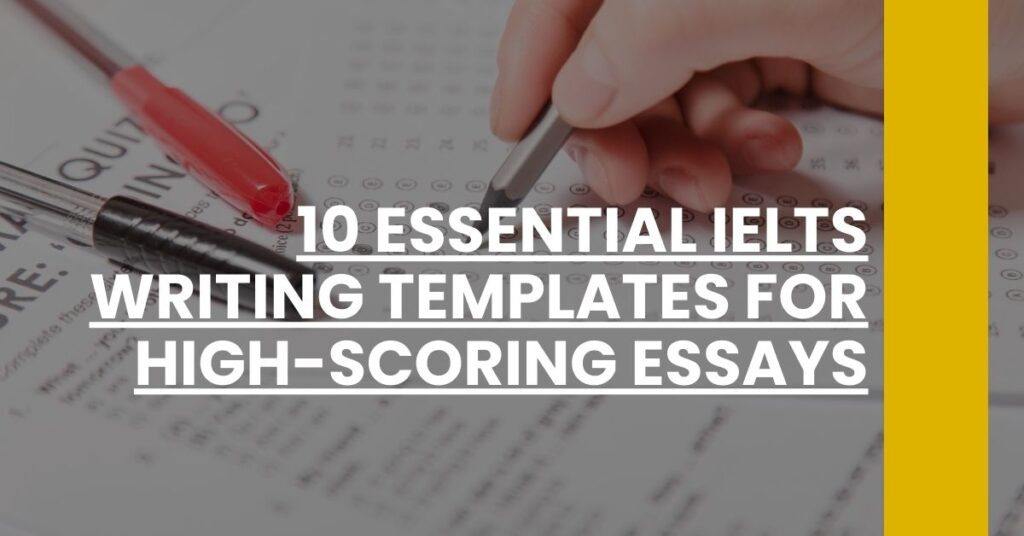Struggling to piece together an IELTS essay that scores high?
The perfect IELTS writing template can be your roadmap to success.
In this article, we distill complex ideas into clear, accessible strategies, equipping you for writing with confidence and precision.
Stay ahead in the IELTS game as we unveil templates designed for peak performance.
- 1. Template for Statement Type Questions
- 2. Agree/Disagree Question Framework
- 3. Advantage/Disadvantage Template
- 4. Analyzing Both Sides of an Argument
- 5. Compare and Contrast Responses
- 6. Problem and Solution Essay Blueprint
- 7. Essays Reflecting Personal Opinion
- 8. Band Score 8 and 9 Essay Strategies
- 9. Distinctions Between Band 7, 8, 9 Scores
- IELTS Academic Writing Samples and Tips
- Related Topics
- Conclusion: Template Mastery for IELTS Success
1. Template for Statement Type Questions
When you’re faced with a statement type question in your IELTS writing task, it’s about crafting an essay that not only reflects your clear understanding of the topic but also demonstrates your ability to organize thoughts logically. The key is to use a structured approach with a clear template.
Introduction: Start with a concise introductory paragraph that outlines the statement and presents your thesis. This sets the tone of your essay and frames your argument.
Body Paragraphs:
- First key idea: Introduce the first supporting argument or example that backs up your thesis.
- Second key idea: Present a second, equally compelling piece of evidence or reasoning to bolster your argument.
- Additional points: Depending on the complexity of the statement, insert more paragraphs to cover further examples or analyses.
Conclusion: Reiterate your thesis, summarizing the key points of your argument.
Use this IELTS writing template as a matrix to build a structured response with a mix of complex sentence structures and advanced vocabulary.
2. Agree/Disagree Question Framework
The agree/disagree questions are a common stumbling block if you’re not prepared. But, with the right IELTS writing template and language strategies, you can handle this task with confidence.
Introduction:
- Clearly state whether you agree or disagree with the given statement.
- Mention the reasons for your stance that will be explored in the body paragraphs.
Body Paragraphs:
- Detail your main reason for agreement or disagreement, providing examples or evidence.
- Explore a secondary reason, furthering your position.
- Consider including a paragraph that addresses a counter-argument or a concession, which showcases your ability to look at issues from multiple angles.
Conclusion: Synthesize the arguments and restate your position to reinforce it firmly.
This guide to crafting an agree/disagree essay is designed to help you balance your argument and ensure that you’re clearly conveying your position.
3. Advantage/Disadvantage Template
Advantage/Disadvantage essays require you to discuss both the pros and cons related to a specific topic. A solid template ensures you give equal consideration to both, presenting a balanced view.
Introduction: Explain the topic and state both potential advantages and disadvantages that will be discussed.
Advantages:
- First advantage: Describe the most significant benefit, providing specific details or examples.
- Additional advantages: Continue with a second or third positive aspect, if necessary.
Disadvantages:
- First disadvantage: Outline the main downside with the topic in question with clear examples.
- Further disadvantages: Expand on any additional negatives, providing depth to your analysis.
Conclusion: Weigh the advantages against the disadvantages and close with a summarizing statement that reflects your overall perspective.
Using this advantages and disadvantages IELTS template can significantly enhance the structure and coherence of your essay.
4. Analyzing Both Sides of an Argument
IELTS essays that ask you to consider both sides of an issue are an opportunity to exhibit your analytical and critical thinking skills. An effective template can guide you to an impartial and comprehensive essay.
Introduction: Introduce the topic at hand and acknowledge that it has multiple perspectives worth considering.
Side One:
- Reason 1: Delve into the first viewpoint with supporting arguments and illustrative examples.
- Reason 2: Add depth with subsequent arguments or insights into the same viewpoint.
Side Two:
- Counter Reason 1: Present the opposing viewpoint with reasons and specific instances.
- Counter Reason 2: Further discuss the counter-arguments, providing a balanced examination.
Conclusion: Provide a summation of the arguments for both sides and your reasoned conclusion, reflecting on the implications or recommendations based on both perspectives.
Consider checking out these strategies for writing effective argumentative essays to ensure a balanced and coherent response.
5. Compare and Contrast Responses
In a compare and contrast IELTS essay, you need to identify similarities and differences between two elements. Here is a structured approach to navigate this type of question effectively.
Introduction: Present an overview of the two elements to be compared and a thesis that indicates the direction your essay will take.
Comparison:
- First similarity: Point out an essential commonality between the two elements.
- Further similarities: Explore additional points of likeness that are relevant.
Contrast:
- First difference: Highlight a prominent difference and support it with specifics.
- Additional differences: Identify other divergent points and elaborate.
Conclusion: Summarize both the comparisons and contrasts, and articulate the significance or conclusion that arises from this analysis.
Leveraging this compare and contrast essay format can help you distinctly put forth both similarities and differences.
6. Problem and Solution Essay Blueprint
In the IELTS writing task, problem-solution essays pose a challenge that can be smoothly navigated with a well-defined template that categorizes the issues and their possible solutions clearly.
Introduction:
- Explain the problem in a sentence or two.
- Briefly outline the solutions you will discuss later in the essay.
Problems:
- Primary problem: Define the most severe problem and provide examples or data.
- Secondary issues: If necessary, discuss additional problems related to the topic.
Solutions:
- Most effective solution: Describe the best potential solution, giving details on implementation and possible implications.
- Alternative solutions: Offer one or two more solutions, discussing the viability and potential outcomes.
Conclusion: Close by evaluating the solutions and suggesting the most effective one, reiterating the need to address the identified problems.
Using a structured problem-solution proposal allows you to critically assess the issues and demonstrate your ability to think constructively.
7. Essays Reflecting Personal Opinion
When it comes to IELTS essays that ask you to reflect your personal opinion, it’s vital to tread a line between expressing yourself and maintaining the academic formalities expected in the test. Your IELTS writing template for these essays should empower you to articulate your thoughts clearly and persuasively without drifting into informality.
Introduction: Briefly lay out the issue at hand and state your opinion, ensuring it’s straightforward and sets the stage for your argument.
Body Paragraphs:
- Primary opinion: Assert your main viewpoint with a compelling argument and back it up with robust evidence or examples.
- Supplementary points: Present additional reasons backing your opinion, each with concrete support.
- Opposing viewpoints: Address a counterargument to show you’ve considered other angles before reaffirming your position.
Conclusion: Restate your opinion and concisely summarize the key points made, leaving readers with a strong sense of your perspective.
For a deeper dive into crafting essays that articulate personal opinions while staying formal, explore this guide on maintaining academic style and tone.
8. Band Score 8 and 9 Essay Strategies
To scale the heights of Band 8 or 9 in IELTS writing, you must cultivate a sophisticated writing style and nuanced argumentation. Here’s what a top-tier IELTS writing template looks like:
Introduction: Frame the essay prompt with a nuanced thesis statement that reflects a multifaceted understanding of the topic.
Body Paragraphs:
- Advanced argument development: Introduce complex ideas and unpack them using detailed support and in-depth analysis.
- Cohesion and coherence: Ensure each paragraph flows seamlessly to the next, with ideas linked through skilled use of cohesive devices.
Conclusion: Echo your thesis in a manner that encapsulates the essay’s depth, leaving no doubt about your advanced language skills.
Aspiring for those high band scores? Incorporate strategies from top band essays, where clear structure meets advanced language proficiency.
9. Distinctions Between Band 7, 8, 9 Scores
Understanding the nuances between Band 7, 8, and 9 essays can provide you with insights on how to elevate your writing. Here’s a quick breakdown:
- Response to the prompt: A Band 7 essay addresses all parts of the task whereas Bands 8 and 9 do so with more thoroughness and insight.
- Coherence and cohesion: Logical sequencing and paragraphing exist at Band 7, but Band 8 and 9 essays showcase an effortless progression of ideas.
- Lexical resource: A range of vocabulary is expected at Band 7, while Bands 8 and 9 demonstrate precision, sophistication, and minimal errors.
For a clearer understanding of the scoring distinctions, see this analysis on the differences in essay bands.
IELTS Academic Writing Samples and Tips
Peeking into samples of high-scoring Academic Writing Task 2 essays can significantly improve your grasp of the IELTS writing template format. These specimens expose you to the kind of thoughtful content, organizational finesse, and linguistic flair that garners high marks.
- Explore varying response styles to understand how successful essays tackle different question types.
- Note the sentence structures that add complexity without sacrificing clarity.
- Take inspiration from the seamless integration of ideas that maintain the reader’s engagement.
Incorporating wisdom from real essay examples can lead to richer content and a more confident writing approach.
Related Topics
As you harness the power of your IELTS writing template, consider broadening your preparation horizons. Reflect on:
- Effective Practice: Regularly write essays using the provided templates to solidify your skills.
- Time Management: Allocate time wisely during the test—plan, write, and review.
- Understanding IELTS Criteria: Familiarize yourself with how essays are scored to target your studying effectively.
These practices, central to your IELTS success, are complemented by a keen attention to avoiding common mistakes and understanding the subtleties in assessment criteria.
Conclusion: Template Mastery for IELTS Success
Your journey toward IELTS success is paved with clarity, coherence, and compelling content. Empower your writing with these meticulously crafted templates, realizing that consistency and practice are the keystones of mastery. Remember, the perfect IELTS writing template is not just a scaffold—it’s a tool to articulate your ideas with precision, making your essay stand out. Keep practicing, and you’ll find that achieving your desired band score is not only possible but probable.
IELTS Writing Template: Elevate your essay quality and boost your band score with our expertly crafted writing templates.

